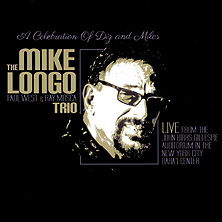 On
his 2012 CD, piano virtuoso and keyboard legend Mike Longo
performs the music of Dizzy Gillespie and Miles Davis for jazz piano
trio. Recorded live at the Baha’i Center in New York City on
June 26, 2012, the 21 track CD, A
Celebration Of Diz And Miles
is an
excellent instrumental music snapshot of Longo’s legendary piano
skills in a jazz trio setting and the results are both timeless and
spectacular. Commenting on paying tribute to these two legendary jazz
artists, Longo adds, “With Dizzy and Charlie Parker came a new
language. An organic change in music occurred and a new way of making
melody was born. Miles was a disciple of this approach and developed
his own unique way of expressing it. Nothing like this innovation
existed before this breakthrough, and it is still not fully understood
even today. Being around Dizzy and playing with him was pure magic!
He was the most amazing human being I have ever encountered.”
In the spirit of the finest sounding piano based live jazz trio albums,
Longo’s grand piano is perfectly recorded, creating a sonic
aura at times. Longo’s trio, including Paul West (bass)
and Ray Mosca (drums) are totally in sync with the sparkling
bop-jazz piano sound. Tastefully produced by Bob Magnuson and
featuring the work of expert sound man, Al Perrotta, A Celebration
Of Diz And Miles also features prominent CD packaging and informative
liner notes by Mike Longo. www.jazzbeat.com
On
his 2012 CD, piano virtuoso and keyboard legend Mike Longo
performs the music of Dizzy Gillespie and Miles Davis for jazz piano
trio. Recorded live at the Baha’i Center in New York City on
June 26, 2012, the 21 track CD, A
Celebration Of Diz And Miles
is an
excellent instrumental music snapshot of Longo’s legendary piano
skills in a jazz trio setting and the results are both timeless and
spectacular. Commenting on paying tribute to these two legendary jazz
artists, Longo adds, “With Dizzy and Charlie Parker came a new
language. An organic change in music occurred and a new way of making
melody was born. Miles was a disciple of this approach and developed
his own unique way of expressing it. Nothing like this innovation
existed before this breakthrough, and it is still not fully understood
even today. Being around Dizzy and playing with him was pure magic!
He was the most amazing human being I have ever encountered.”
In the spirit of the finest sounding piano based live jazz trio albums,
Longo’s grand piano is perfectly recorded, creating a sonic
aura at times. Longo’s trio, including Paul West (bass)
and Ray Mosca (drums) are totally in sync with the sparkling
bop-jazz piano sound. Tastefully produced by Bob Magnuson and
featuring the work of expert sound man, Al Perrotta, A Celebration
Of Diz And Miles also features prominent CD packaging and informative
liner notes by Mike Longo. www.jazzbeat.com
mwe3.com presents an interview
with
MIKE LONGO
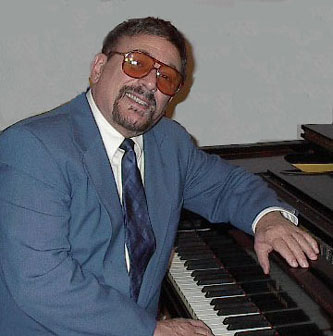 mwe3:
Can you say something about where you were born and I know you
came from a musical background and I also read you grew up in Ft.
Lauderdale Florida which is right next to Pompano Beach. What was
Florida like back then? When did you first come to New York and long
have you now lived in the NYC area?
mwe3:
Can you say something about where you were born and I know you
came from a musical background and I also read you grew up in Ft.
Lauderdale Florida which is right next to Pompano Beach. What was
Florida like back then? When did you first come to New York and long
have you now lived in the NYC area?
MIKE LONGO: I was born in Cincinnati, Ohio but my family moved
to Ft. Lauderdale when I was 8 years old. I grew up there through
high school. Back then Ft. Lauderdale was this little naval air station
town and very rural. Downtown Ft. Lauderdale was the hub for all of
the activity, with its waterfront on New River and the fleet of fishing
boats and local cruise boats. There were two strip clubs—the
club Aloha and the Doll House. This was the only place at the time
where jazz was played. Groups would play the show for the strippers
and then play jazz between the shows. Cannonball Adderley was the
band director at Dillard High School and I met him at a jam session
at the youth center in Hollywood. There was a local disc jockey by
the name of Leonce Picou who had a midnight to 6 AM jazz show on WFTL.
He had been putting on jam sessions in youth centers to help stem
teen age drinking which was claiming a lot of young lives in DUI accidents
at the time. My dad had a club date band, and I told him about Cannonball,
and he began using him on club dates. Cannon got me and a drummer
by the name of Pete Helmintoller, also a school mate of mine in the
10th grade, a gig with a rhythm and blues band led by a trumpeter
named Harold Ferguson. We played up and down the coast on what they
used to call the “Chitlin’ Circuit”. After graduation
from Ft. Lauderdale High my dad asked Cannonball to recommend a college
for me and he recommended Western Kentucky University because when
he was in the army stationed at Ft. Knox in Louisville, Kentucky,
he would travel to Bowling Green to study privately with Roy Harris,
the composer, who was head of the music department there. After graduation
from college I didn’t have a dime to my name, trombone player,
Bill Bartell, recommended me for a gig with this trad band by the
name of The Salt City Six out of Syracuse, NY. I walked off the stage
with my degree in my hand and jumped into a car with my girlfriend
who drove me to Buffalo, NY where I opened with The Salt City Six
the next night. I toured with them for two years. A few times they
would play the Metropole in New York where I made some friends. Finally
on one of the Salt City Six gigs the Metropole offered me a position
as one of their house pianists. I left the Salt City Six and stayed
on at the Metropole for the next two years. 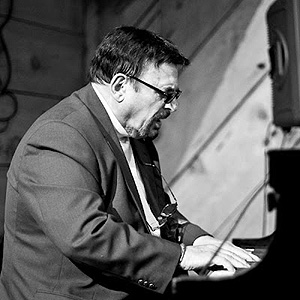 I
was playing a double shift as they had six bands a day working there,
two downstairs during the day and another two at night and also another
two on the second floor at night. I was working during the day with
the older cats like Tony Parentti, George Wettling, Coleman Hawkins
and Zutty Singleton from 2:00 in the afternoon until 8:00 PM and then
from 10:00 PM until 4:00 AM with Henry Red Allen or Sol Yaged and
sometimes Gene Krupa. I was staying at the Belvadere Hotel which was
just around the corner. Just soaking up everything there was to learn
from these musicians. I was the young kid on the block working with
the old timers. While working there, an occasion arose when Dizzy
Gillespie was playing in the Modern Jazz room on the second floor.
When he would go on a break he would have to walk past where we were
playing downstairs. I got a call from a bass player in Ft. Lauderdale
a couple of months later asking me if I had seen the interview with
Dizzy in the International Music Magazine. Apparently Dizzy was asked
if he had heard any young musicians that impressed him and he mentioned
me. While working there trumpeter Jimmy McPartland asked me to play
two weeks with him in Chicago at a place called Bourbon Street. I
went and while there met Oscar Peterson at the London House. He heard
me play and asked if I would like to study with him. I jumped at the
chance and spent the next six months in Toronto as his student. I
returned to New York in 1961 and have lived here ever since.
I
was playing a double shift as they had six bands a day working there,
two downstairs during the day and another two at night and also another
two on the second floor at night. I was working during the day with
the older cats like Tony Parentti, George Wettling, Coleman Hawkins
and Zutty Singleton from 2:00 in the afternoon until 8:00 PM and then
from 10:00 PM until 4:00 AM with Henry Red Allen or Sol Yaged and
sometimes Gene Krupa. I was staying at the Belvadere Hotel which was
just around the corner. Just soaking up everything there was to learn
from these musicians. I was the young kid on the block working with
the old timers. While working there, an occasion arose when Dizzy
Gillespie was playing in the Modern Jazz room on the second floor.
When he would go on a break he would have to walk past where we were
playing downstairs. I got a call from a bass player in Ft. Lauderdale
a couple of months later asking me if I had seen the interview with
Dizzy in the International Music Magazine. Apparently Dizzy was asked
if he had heard any young musicians that impressed him and he mentioned
me. While working there trumpeter Jimmy McPartland asked me to play
two weeks with him in Chicago at a place called Bourbon Street. I
went and while there met Oscar Peterson at the London House. He heard
me play and asked if I would like to study with him. I jumped at the
chance and spent the next six months in Toronto as his student. I
returned to New York in 1961 and have lived here ever since.
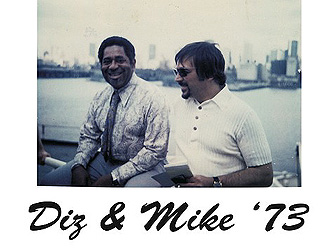 mwe3:
Can you say something about the significance of both Dizzy Gillespie
and Miles Davis on the jazz world and the world of 20th century music?
Some listeners and musicians alike who weren’t born during their
lifetimes might not have yet discovered them yet.
mwe3:
Can you say something about the significance of both Dizzy Gillespie
and Miles Davis on the jazz world and the world of 20th century music?
Some listeners and musicians alike who weren’t born during their
lifetimes might not have yet discovered them yet.
MIKE LONGO: With Dizzy and Charlie Parker came a new language.
An organic change in music occurred and a new way of making melody
was born. Miles was a disciple of this approach and developed his
own unique way of expressing it. Nothing like this innovation existed
before this breakthrough, and it is still not fully understood even
today. It has deep spiritual, psychological and physiological significance
and the ability to transform people, who listen to it and understand
it, into an alternate universe kind of existence.
mwe3: Performing with Dizzy Gillespie when you were younger
must have been amazing. How would you describe Dizzy as a musician
and as a friend of yours, what was his personality like? Also where
would you recommend that newcomers start to discover Dizzy’s
music on record and video and what are a few of your favorite albums
by Dizzy and Miles?
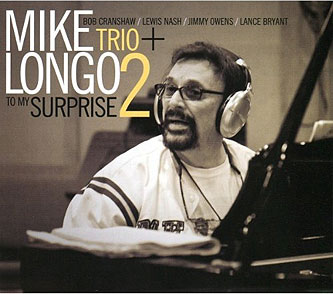 MIKE
LONGO: Being around Dizzy and playing with him was pure magic!
He was the most amazing human being I have ever encountered. He knew
something the rest of us need to find out about, as I never saw him
depressed. He was a creature of joy every waking minute of his life.
As a musician he was a profound genius in touch with a certain aspect
of Divinity. For newcomers I would recommend listening to an album
called For Musicians Only featuring Diz with Sonny Stitt, Stan
Getz, Ray Brown, Herb Ellis and Stan Levy. Also check out a recording
called The Gifted Ones with Dizzy and Count Basie. It is listed
as a Count Basie recording but pay particular attention to a track
called “Constantenople”. Dizzy On The French Riviera
is another enjoyable experience and one that I am on called Swing
Low Sweet Cadillac. With Miles I think Kind Of Blue is
a must as well as the collaborations he did with Gil Evans. Also I
would recommend Birth Of The Cool.
MIKE
LONGO: Being around Dizzy and playing with him was pure magic!
He was the most amazing human being I have ever encountered. He knew
something the rest of us need to find out about, as I never saw him
depressed. He was a creature of joy every waking minute of his life.
As a musician he was a profound genius in touch with a certain aspect
of Divinity. For newcomers I would recommend listening to an album
called For Musicians Only featuring Diz with Sonny Stitt, Stan
Getz, Ray Brown, Herb Ellis and Stan Levy. Also check out a recording
called The Gifted Ones with Dizzy and Count Basie. It is listed
as a Count Basie recording but pay particular attention to a track
called “Constantenople”. Dizzy On The French Riviera
is another enjoyable experience and one that I am on called Swing
Low Sweet Cadillac. With Miles I think Kind Of Blue is
a must as well as the collaborations he did with Gil Evans. Also I
would recommend Birth Of The Cool.
mwe3: What were the events that lead to you recording and
recently releasing your new CD with The Mike Longo Trio, A Celebration
Of Diz And Miles and can you say something about working with
CAP Records, and how long have you been involved with that legendary
label?
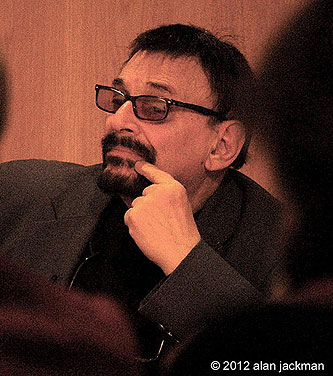 MIKE
LONGO: It wasn’t a planned recording. I run a weekly jazz
series in the John Birks Gillespie Auditorium in the NYC Baha’i
center and about every 5 weeks or so I perform there with one of my
groups. I have the big band known as the NY State of the Art Jazz
Ensemble. I also have a funk band and my trio. We have noticed of
late that theme based concerts draw larger audiences so I decided
to do a tribute to Diz and Miles on June 26th, 2012, with my trio.
Bob Magnuson, the lead alto player on my big band, has professional
recording equipment and decided to record the concert. It came out
so well that we decided to release it on CAP. I have been involved
with CAP since 1979. It started out as a very small label but now
has grown to a catalog of over 150 releases. The great thing about
CAP is it leaves the entire creative control to the artists themselves.
What you hear on a CAP recording is exactly what the artist wanted
you to hear, unlike many labels who have producers, some of who are
failed musicians, trying to make creative decisions as to what an
artist should record and how it should be recorded.
MIKE
LONGO: It wasn’t a planned recording. I run a weekly jazz
series in the John Birks Gillespie Auditorium in the NYC Baha’i
center and about every 5 weeks or so I perform there with one of my
groups. I have the big band known as the NY State of the Art Jazz
Ensemble. I also have a funk band and my trio. We have noticed of
late that theme based concerts draw larger audiences so I decided
to do a tribute to Diz and Miles on June 26th, 2012, with my trio.
Bob Magnuson, the lead alto player on my big band, has professional
recording equipment and decided to record the concert. It came out
so well that we decided to release it on CAP. I have been involved
with CAP since 1979. It started out as a very small label but now
has grown to a catalog of over 150 releases. The great thing about
CAP is it leaves the entire creative control to the artists themselves.
What you hear on a CAP recording is exactly what the artist wanted
you to hear, unlike many labels who have producers, some of who are
failed musicians, trying to make creative decisions as to what an
artist should record and how it should be recorded.
mwe3: You recorded your Celebration Of Diz And Miles
album at the Baha’i Temple in on 11th street in Manhattan and
in the CD liner notes you single out the Yamaha C1 Baby Grand piano
as being essential to the making of the CD. Can you say something
about that piano, what about the C1 sound that is so captivating,
as well as discussing your other pianos that you enjoy performing
and recording on. Are some pianos better for live concerts and others
better for recording? My dentist had an office on the 11th floor in
the Steinway building on 57th street overlooking Horn & Hardart.
I guess Steinway owned the whole building. Steinway is certainly an
amazing story.
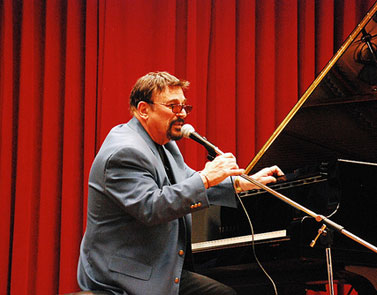 MIKE
LONGO: Actually, I am a Steinway artist and have been for about
four years now. It just so happened that a couple by the name of Kate
and Rich Weisman donated the Yamaha C1 to the jazz series at the Baha’i
center and that is why it is on my recording. I have recorded often
on Steinways, not to mention Baldwins as well. I think people make
a mistake, generally, in the questions posed here because a pianist’s
touch is a very personal thing relative to his or her identity and
often times these qualities are attributed to the piano being played
instead of the source of the tone produced by the individual’s
touch. For example you could take the exact same instrument and after
a few notes identify that as Bill Evans or Erroll Garner, or Oscar
Peterson, etc., even though they all are playing the same instrument.
MIKE
LONGO: Actually, I am a Steinway artist and have been for about
four years now. It just so happened that a couple by the name of Kate
and Rich Weisman donated the Yamaha C1 to the jazz series at the Baha’i
center and that is why it is on my recording. I have recorded often
on Steinways, not to mention Baldwins as well. I think people make
a mistake, generally, in the questions posed here because a pianist’s
touch is a very personal thing relative to his or her identity and
often times these qualities are attributed to the piano being played
instead of the source of the tone produced by the individual’s
touch. For example you could take the exact same instrument and after
a few notes identify that as Bill Evans or Erroll Garner, or Oscar
Peterson, etc., even though they all are playing the same instrument.
mwe3: Speaking of the album recorded at the Baha’i center,
what was it that got you interested in the Baha’i religion and
what led to your “Jazz Tuesdays” series and is it still
ongoing ?
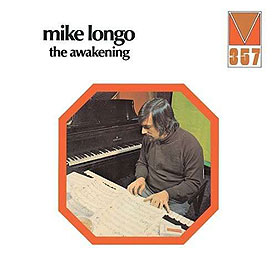 MIKE
LONGO: When I first went with Dizzy the country was in the grips
of a social crisis. Race riots were happening as the civil rights
movement was taking shape. At the time, to my knowledge, I was probably
the only caucasian musician working in an all black group. Things
got pretty scary at times and I even got hit with a bottle on stage
in a concert in Pittsburgh. Dizzy and I became close friends along
with James Moody and me. Dizzy shared my belief that things didn’t
have to be that way between whites and blacks and concluded that there
had to be another way. When Diz found out about the Baha’i Faith
it turned out to be “the other way” for him as one of their
primary goals was race unity. He started to turn me on to their literature
and on the day after Martin King was assassinated Diz declared himself
a Baha’i. It took me another five years to accept the faith and
then I declared as well. After Dizzy passed away in 1993 I recalled
how back in the 1960s there used to be this loft scene in New York
whereby the upper floors of industrial buildings were being converted
into concert venues where people could hear jazz at nominal fees.
The music could go on into the wee hours of the morning since they
were not in residential areas but commercial areas. I recall a bass
player by the name of Jimmy
MIKE
LONGO: When I first went with Dizzy the country was in the grips
of a social crisis. Race riots were happening as the civil rights
movement was taking shape. At the time, to my knowledge, I was probably
the only caucasian musician working in an all black group. Things
got pretty scary at times and I even got hit with a bottle on stage
in a concert in Pittsburgh. Dizzy and I became close friends along
with James Moody and me. Dizzy shared my belief that things didn’t
have to be that way between whites and blacks and concluded that there
had to be another way. When Diz found out about the Baha’i Faith
it turned out to be “the other way” for him as one of their
primary goals was race unity. He started to turn me on to their literature
and on the day after Martin King was assassinated Diz declared himself
a Baha’i. It took me another five years to accept the faith and
then I declared as well. After Dizzy passed away in 1993 I recalled
how back in the 1960s there used to be this loft scene in New York
whereby the upper floors of industrial buildings were being converted
into concert venues where people could hear jazz at nominal fees.
The music could go on into the wee hours of the morning since they
were not in residential areas but commercial areas. I recall a bass
player by the name of Jimmy 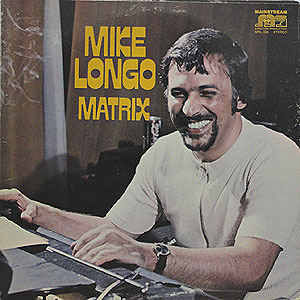 Stevens
had a loft down in Soho where he would have jam sessions. I played
there all night from about 8:00 PM until 11:00 AM the next morning
with George Coleman, Chuck Mangione, a drummer by the name of Vinny
Regerio and the bass player from Lionel Hampton’s band by the
name of Benny. We would do that on a regular basis just to practice
and play together with no audience. Just five musicians groovin’.
I began thinking in 2004 that there must be a way to have something
like this today as it is really needed. The musicians weren’t
playing enough and the prices in the major jazz clubs, due to the
high rents, were out of reach for the average jazz fan. It suddenly
occurred to me that the Baha’i Center had this beautiful 160
seat theater within it that was being used on occasions to hold religious
services but for the most part being unused. I approached the Baha’is
about starting a weekly jazz series in Dizzy’s name and convinced
them to officially name the theater the John Birks Gillespie Auditorium.
They thought it was a great idea since both Dizzy and I were Baha’is.
I got permission from Lorraine Gillespie to use Dizzy’s name
and the series started on January 6th, 2004, the one year anniversary
of Dizzy’s death and ironically the birthday of Lorraine Gillespie,
his widow. We have been operating ever since. One of my three groups
performs there about every 5 weeks and the other weeks I book other
world class jazz artists there. The set lists are entirely up to the
musicians performing and all the proceeds from the box office go directly
to them.
Stevens
had a loft down in Soho where he would have jam sessions. I played
there all night from about 8:00 PM until 11:00 AM the next morning
with George Coleman, Chuck Mangione, a drummer by the name of Vinny
Regerio and the bass player from Lionel Hampton’s band by the
name of Benny. We would do that on a regular basis just to practice
and play together with no audience. Just five musicians groovin’.
I began thinking in 2004 that there must be a way to have something
like this today as it is really needed. The musicians weren’t
playing enough and the prices in the major jazz clubs, due to the
high rents, were out of reach for the average jazz fan. It suddenly
occurred to me that the Baha’i Center had this beautiful 160
seat theater within it that was being used on occasions to hold religious
services but for the most part being unused. I approached the Baha’is
about starting a weekly jazz series in Dizzy’s name and convinced
them to officially name the theater the John Birks Gillespie Auditorium.
They thought it was a great idea since both Dizzy and I were Baha’is.
I got permission from Lorraine Gillespie to use Dizzy’s name
and the series started on January 6th, 2004, the one year anniversary
of Dizzy’s death and ironically the birthday of Lorraine Gillespie,
his widow. We have been operating ever since. One of my three groups
performs there about every 5 weeks and the other weeks I book other
world class jazz artists there. The set lists are entirely up to the
musicians performing and all the proceeds from the box office go directly
to them.
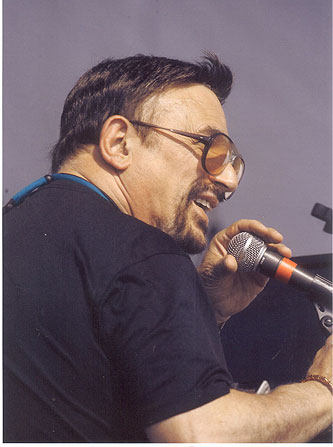 mwe3:
One thing that really stuck out in my mind after hearing the Celebration
Of Diz And Miles CD was the amazingly well recorded sound which
was quite clean and distortion free. What was the recording process
like and what role did producer Bob Magnuson have in the making of
the album?
mwe3:
One thing that really stuck out in my mind after hearing the Celebration
Of Diz And Miles CD was the amazingly well recorded sound which
was quite clean and distortion free. What was the recording process
like and what role did producer Bob Magnuson have in the making of
the album?
MIKE
LONGO: As I mentioned earlier Bob Magnuson is the lead altoist
on my big band but is also one of the most successful studio musicians
on the New York scene. He is also a producer and runs his own jingle
production company out of his office and is quite skilled with recording
techniques. It should also be mentioned that the sound of the recording
was also due to the skills of Al Perrotta who did the mixing and mastering.
He and Bob collaborated on my last three releases. Al was with Tony
Bennett’s son’s studio in New Jersey until it closed recently
and now works on a freelance basis. He is a master of his craft as
is Bob Magnuson. Also Bob is a great musician and can hear the music
properly and knows how to record it to get it heard as it was intended.
mwe3: How did you go about deciding what tracks you would record
on the CD from the repertoires of both Dizzy and Miles? Did you have
some parameters during the making of the album and what other “Celebration”
series albums might you consider releasing in the future?
MIKE LONGO: As I said earlier, we did not intend to make an
album. I just picked some of the tunes they wrote or recorded that
I like to play, I gave the bass player and drummer a list, and we
counted four and started blowing. I am toying with an idea to do a
Wayne Shorter tribute album as he is one of my favorite composers.
mwe3: Can you say something about your upcoming 4 DVD instructional
series The Rhythmic Nature Of Jazz and when will is be released
and what company is putting it out? Are you still involved in teaching
and what courses do you most enjoy teaching?
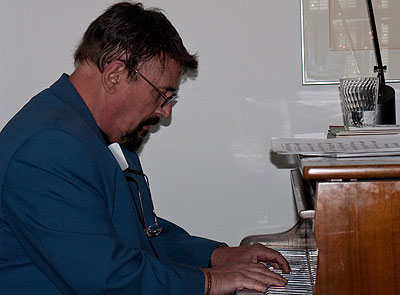 MIKE
LONGO: I have two new DVDs out now called The Rhythmic Nature
of Jazz Vol. I and II. There will eventually be four volumes and
they are based on the rhythmic concepts I learned from Dizzy which
are profound. They are available at www.jazzbeat.com.
They are also put out by CAP. I teach privately three days a week
from my studio in New York when I am not on the road. I am also on
the faculty at Sarah Lawrence College. I have a variety of students,
most of them pianists. I also have horn players, bassists, drummers
and singers as well who study the jazz concepts I teach. I also teach
composition and arranging. I teach everyone differently depending
on their needs. My approach is to ask myself, “What is this person
trying to do and how can I help them do it”, and we proceed from
there.
MIKE
LONGO: I have two new DVDs out now called The Rhythmic Nature
of Jazz Vol. I and II. There will eventually be four volumes and
they are based on the rhythmic concepts I learned from Dizzy which
are profound. They are available at www.jazzbeat.com.
They are also put out by CAP. I teach privately three days a week
from my studio in New York when I am not on the road. I am also on
the faculty at Sarah Lawrence College. I have a variety of students,
most of them pianists. I also have horn players, bassists, drummers
and singers as well who study the jazz concepts I teach. I also teach
composition and arranging. I teach everyone differently depending
on their needs. My approach is to ask myself, “What is this person
trying to do and how can I help them do it”, and we proceed from
there.
mwe3: What are some of your other interests outside of the
music world?
MIKE LONGO: Music consumes most of my time but I do enjoy bass
fishing as a hobby. I am also a football and boxing fan and watch
games and sporting events frequently on TV.
mwe3: What are some of your upcoming plans in 2013 as far as
writing, recording and also performing music?
MIKE LONGO: I am planning to do a kickstarter campaign to help
fund a recording of my big band. Since our last recording I have written
over 30 charts that have not been recorded as of yet and would like
to see this come about. I am performing with the big band this coming
Tuesday, 01/22/13 at the John Birks  Gillespie
Auditorium in New York and then on the following Saturday, 01/26/13
at Trumpets Jazz Club in Montclair NJ. On February 26th I will be
performing with the trio doing a concert of “The American Songbook”
at the Gillespie Auditorium and we are also playing a concert in April
at Rockafeller University in New York. I will be doing some traveling
on my own as well as I frequently do master classes and concerts at
different universities with groups comprised of the students there.
I play several times a year with either the big band, trio or funk
band at the Gillespie auditorium as well. So far in 2013 I have composed
two new compositions and arrangements that we are performing this
coming week and I have jotted down notes on different motifs I plan
to incorporate into large scale works for the large ensemble throughout
the year. I will also be recording another trio CD this summer with
Bob Cranshaw and Lewis Nash. All in all, it is shaping up to be a
pretty busy and creative year.
Gillespie
Auditorium in New York and then on the following Saturday, 01/26/13
at Trumpets Jazz Club in Montclair NJ. On February 26th I will be
performing with the trio doing a concert of “The American Songbook”
at the Gillespie Auditorium and we are also playing a concert in April
at Rockafeller University in New York. I will be doing some traveling
on my own as well as I frequently do master classes and concerts at
different universities with groups comprised of the students there.
I play several times a year with either the big band, trio or funk
band at the Gillespie auditorium as well. So far in 2013 I have composed
two new compositions and arrangements that we are performing this
coming week and I have jotted down notes on different motifs I plan
to incorporate into large scale works for the large ensemble throughout
the year. I will also be recording another trio CD this summer with
Bob Cranshaw and Lewis Nash. All in all, it is shaping up to be a
pretty busy and creative year.
Thanks to Mike Longo @ www.jazzbeat.com



